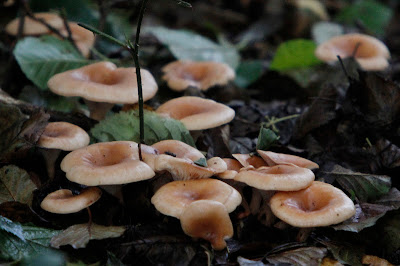Firstly , many thanks to Neil , Alan P , Ken and Alan W , for correcting my raptor ID on my last post . I will still have to wait for a Bromley Marsh Harrier , and settle for Com. Buzzard this time .
A quick catch up on a trip to Sevenoaks Reserve and surrounding area on Monday .
Everything was still dripping when I arrived , and even caught the Little Egrets in bed .
A nice show of Tawny Funnel Cap / Clitocybe flaccida along the main track .
It wouldn't surprise me if the Rose-ringed Parakeets aren't still nesting , with two females guarding their nest holes . A male was on sentry duty in the trees above .
Siskin numbers are on the increase on the site , having seen a flock of 50+ over Long Lake , and also half a dozen Lesser Redpolls close to Willow Hide . In the same areas I had three sightings of Kingfisher , but didn't get a shot of any of them .
In Tyler Hide , a Blue Tit was in panic mode trying to find a way out , having flown in the open entrance , but obviously unable to relocate the opening . It seemed relieved when I gently caught it and released it outside .
Good numbers of Clouded Agaric / Clitocybe nebularis on the way to Tower Hide .
The rest of the visit was very quiet . With the early darkness approaching , I decide to try for a pair of
Barn Owls that a friend had told me about , on the way photographing a very well marked Common Buzzard . Shortly after arrival , I met up unexpectedly with him . We made our way to the site and waited , with a constant threat of rain , which came , but with the added
bonus of a rainbow . After a lot of waiting , and thoughts that neither would show , the female
appeared and perched on a fence post in the fading light . No sign of the male , but she started to
quarter the surrounding fields . She then perched on another fence post , quizzically looking into the
surrounding grassland . Eventually she swooped down into the grass , but failed to get her meal . A few more minutes quartering , then a Magpie started giving her grief , and she disappeared . We waited hoping she would return , but she didn't . But I'm sure I will be returning , especially when the Winter takes hold and they might well be forced to hunt during daylight hours .
5 hours ago





































.JPG)



















